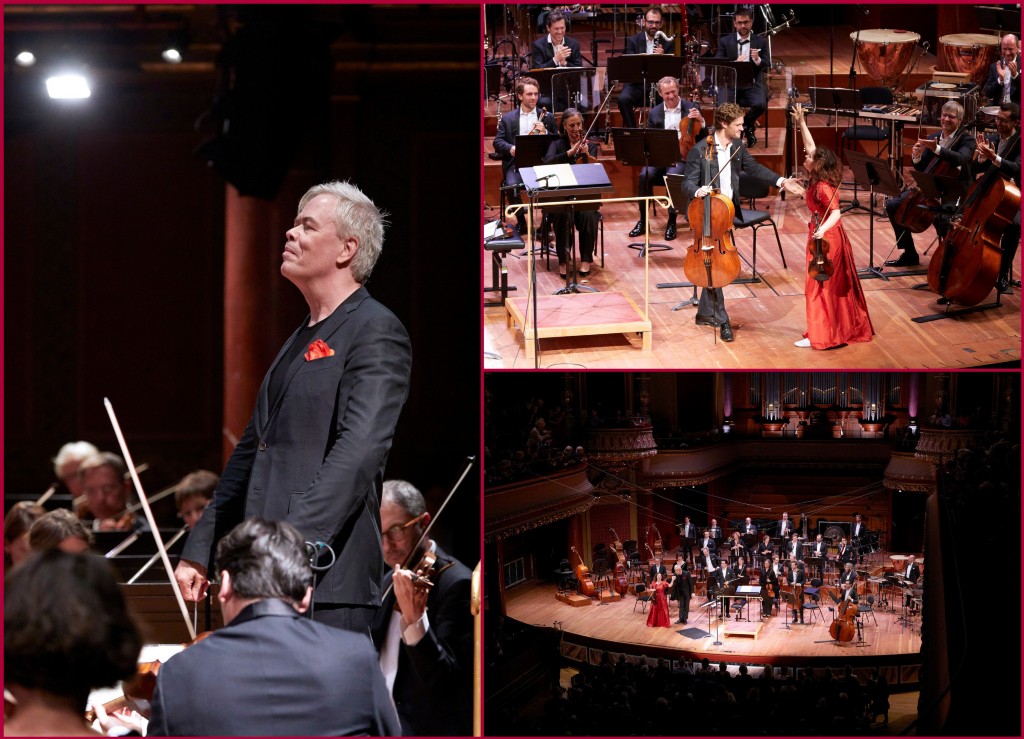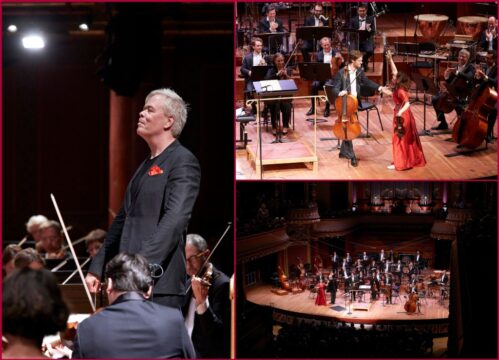In the vastness of the classical repertoire, some evenings seem to transcend the mere experience of a concert, touching on something deeper, a place where the composer's soul meets that of the listener in a silent yet powerful exchange. This was the case during the evening of October 12th at Victoria Hall in Geneva, which saw the convergence of Sibelius, Ligeti, and Beethoven, three giants with distinct aesthetics but united in their tireless quest for truth through music. Under the inspired direction of Hannu Lintu, the Orchestre de la Suisse Romande became the medium through which these works took on new life, pulsating with an intensity that seemed ready to spill over from the stage. From the first notes of Sibelius's patriotic work, through the deliriums of Ligeti's Violin Concerto, embodied by the extraordinary soloist Patricia Kopatchinskaya, to the dazzling finale of Beethoven's Seventh Symphony, this evening was a celebration of music not just as art, but as a vital force. A journey through epochs, styles, and emotions, eloquently illustrating music's ability to elevate, challenge, and deeply move. Beyond a mere concert, an uplifting and cathartic experience.
Sibelius's Finlandia: A Dazzling Epic Narrative
The evening began by delving into the depths of Finnish patriotism with Jean Sibelius's Finlandia, a piece that is not just a musical composition, but a slice of Finnish national history, woven into the fabric of time. Created during a period of turbulence and cultural resistance, Finlandia emerged from the need to preserve national identity amidst Russian oppression. It symbolizes Finland's indomitable spirit and its quest for self-determination and freedom. In this performance, Hannu Lintu did not just conduct an orchestra; he evoked the soul of a nation. With deliberately expansive tempi, he created a space in which the music breathes pride and nostalgia, a stylistic choice that, although devoid of legato, allows for the unfolding of a profound narrative intensity. There is a distinct echo in his direction, a reminiscence of Kullervo, Sibelius's symphonic poem itself an evocation of the Kalevala, the Finnish national epic. This connection is not merely musical but viscerally cultural, intertwining folklore and history into a solemn symphonic narrative.
Lintu's conducting is a dance in itself, precise and energetic, as if he were wielding a foil rather than a baton. Each movement is a thrust of intent, sculpting the sound space with masculinity and dappled finesse. We appreciate not only the sonority but also this silent choreography, particularly palpable in the work's final section, where controlled sobriety balances vigor with elegant restraint. The Orchestre de la Suisse Romande transforms under his direction. The musicians are no longer just an ensemble; they embody the Finnish character, with an idiomatic mimicry that transcends performance to become testimony. The strings weep, the brass proclaims, and each timpani strike resounds like a beating heart, intense and fiery, reflecting the northern lights and the dark forests that are the very essence of Finland. This is not a mere concert opening; it's a declaration, an affirmation of identity and resilience, and a poignant tribute to the land that nurtured Sibelius and continues to inspire Finnish conductors, who fully breathe the truth of this music we would decidedly like to hear more of in our regions.
Lintu's conducting is a dance in itself, precise and energetic, as if he were wielding a foil rather than a baton. Each movement is a thrust of intent, sculpting the sound space with masculinity and dappled finesse. We appreciate not only the sonority but also this silent choreography, particularly palpable in the work's final section, where controlled sobriety balances vigor with elegant restraint. The Orchestre de la Suisse Romande transforms under his direction. The musicians are no longer just an ensemble; they embody the Finnish character, with an idiomatic mimicry that transcends performance to become testimony. The strings weep, the brass proclaims, and each timpani strike resounds like a beating heart, intense and fiery, reflecting the northern lights and the dark forests that are the very essence of Finland. This is not a mere concert opening; it's a declaration, an affirmation of identity and resilience, and a poignant tribute to the land that nurtured Sibelius and continues to inspire Finnish conductors, who fully breathe the truth of this music we would decidedly like to hear more of in our regions.
The Ligeti’s Violin Concerto: A Sonic Odyssey at the Edge of Music
After immersing in the solemn patriotism of Finlandia, the stage morphs into an alien, almost extraterrestrial soundscape with György Ligeti's Violin Concerto. This complex and unclassifiable work stands as a testament to Ligeti's genius, a composer who pushed the boundaries not just of music, but of what we perceive as real and unreal. Composed throughout the 1980s and 90s, this concerto encapsulates Ligeti's relentless quest for innovation, incorporating elements of traditional music, modernism, and even auditory illusion. The performance begins in an almost ethereal manner, with a start reminiscent of Sibelius's soundscapes but morphs into a listening experience that defies understanding and expectations. Patricia Kopatchinskaja, dressed all in red, literally embodies this work, to the point of making the conductor forgettable! Her violin meows, cries, laughs, in a range of expressions that seems almost superhuman; she bewitches the audience with her approach to the second part in an even more challenging revelation, mixing contemplative Eastern sounds with the unexpected use of ocarinas, turning the stage into a deep meditation on sound and silence. Her violin is not an instrument, it is an extension of her own body, depicting a bold choreography of sound and movement. The third movement exploits the violin's high-pitched register, creating a fantastical and whimsical world, while the fourth offers a staggering contrast with a pianissimo clarinet evoking the vastness and mystery of space. By far, it's the most thrilling moment of the evening, for its incredible physical and spiritual intensity, in these moments of suspended time where something impalpable happens, creating an almost religious and hypnotic communion between musicians and audience.
Diving headfirst into the sonic abyss, this fourth movement explodes, defying comprehension, overturning the senses, tearing the listener away from any preconceived notion of musical reality. There, in a barely audible breath, a clarinet reveals its clandestine notes, evoking a parallel universe where music is no longer sequence, but essence. We are no longer in a concert hall; we are sucked into a sonic vortex, a black hole where time distorts and space resonates. Sounds intertwine, slither, confront in a cosmic dance, creating an auditory labyrinth where each note is a star, each pattern, a constellation. Ligeti holds us weightless in this static river, where waters do not flow, but vibrate, pulse, emanate from an unfathomable source. The listener, deprived of bearings, has no choice but to let themselves be overwhelmed, to dissolve into this immensity where echoes of an unexplored universe resonate. We can't help but see, through synesthesia, a mysterious black monolith arising in our minds, immense, impenetrable, reflecting our image twisted by sound waves. This neo-Space Odyssey is ours, intimate, terrifying, magnificent, magnetic. Kopatchinskaja, the scarlet flame, becomes our guide, our priestess, our Ariadne's thread in this maze of resonances and silences. She doesn't play; she invokes. Her violin, an extension of her soul, cries, laughs, screams, whispers. Soulages, master of beyond black, painter of luminous darkness, is there too. Each note is a brush dipped in the ink of infinity, each musical phrase a brush that caresses the canvas of our consciousness. Darkness is not the absence of light; it is the presence of mystery. And in this mystery, Kopatchinskaja dances, spins, struggles, and loves. Her bow is her partner, her adversary, her lover. The violin pushes the boundaries of what an instrument can express, of what a heart can feel. From crystalline heights to rumbling abysses, it knows no boundaries, no taboos. Everything is permitted, everything is necessary. Ligeti's audacity meets Kopatchinskaja's bravery, and together, they offer us not a performance, but a rite of passage.
Her playing in the fifth movement becomes shamanic, invoking images of Dionysian trances, Mexican forests, and even Mayan sacrifice rituals. It's the musical equivalent of the "theatre de la cruauté" Antonin Artaud spoke of in its purest form, leaving the audience dumbstruck, gasping, and ecstatic. How can a violin produce such sounds, such emotions? It's a delirium of musical genius, culminating with the violinist whistling and singing while the orchestra simulates a chaotic battle. The work concludes, leaving behind a silence that resonates louder than any music. We are no longer the same. We have traveled beyond the stars, dove into the depths of our being, confronted the ghosts of our fears, and the demons of our desires. Patricia Kopatchinskaja, accompanied by the valiant musicians of the OSR, did not give us a concert. She gave us a rebirth. Undeniably, a work to see, more than to hear.
The encore was just as generous and captivating, with Intermezzo, Giocoso-serioso, and Nein! showcasing Patricia Kopatchinskaja's virtuosity, not only as a performer but also as a composer. An experimental dialogue, delivered with one of the first cellos, Lionel Cottet, impeccable and complicit, this piece is the ideal extension of Ligeti's concerto. The second encore, Ballade and Dance for Two Violins, by Ligeti, but wiser, more classic, refreshing, and virtuosic, with the participation of David Guerchovicth, an additional musician not part of the OSR, allows us to appreciate the beautiful generosity of an atypical artist.
In total, with Ligeti, we experience a catharsis, an exploration of the limits of music, sound, and human experience. It's a demonstration that music is not a static art but a constantly expanding universe, challenged and redefined by brave artists like Patricia Kopatchinskaja.
Diving headfirst into the sonic abyss, this fourth movement explodes, defying comprehension, overturning the senses, tearing the listener away from any preconceived notion of musical reality. There, in a barely audible breath, a clarinet reveals its clandestine notes, evoking a parallel universe where music is no longer sequence, but essence. We are no longer in a concert hall; we are sucked into a sonic vortex, a black hole where time distorts and space resonates. Sounds intertwine, slither, confront in a cosmic dance, creating an auditory labyrinth where each note is a star, each pattern, a constellation. Ligeti holds us weightless in this static river, where waters do not flow, but vibrate, pulse, emanate from an unfathomable source. The listener, deprived of bearings, has no choice but to let themselves be overwhelmed, to dissolve into this immensity where echoes of an unexplored universe resonate. We can't help but see, through synesthesia, a mysterious black monolith arising in our minds, immense, impenetrable, reflecting our image twisted by sound waves. This neo-Space Odyssey is ours, intimate, terrifying, magnificent, magnetic. Kopatchinskaja, the scarlet flame, becomes our guide, our priestess, our Ariadne's thread in this maze of resonances and silences. She doesn't play; she invokes. Her violin, an extension of her soul, cries, laughs, screams, whispers. Soulages, master of beyond black, painter of luminous darkness, is there too. Each note is a brush dipped in the ink of infinity, each musical phrase a brush that caresses the canvas of our consciousness. Darkness is not the absence of light; it is the presence of mystery. And in this mystery, Kopatchinskaja dances, spins, struggles, and loves. Her bow is her partner, her adversary, her lover. The violin pushes the boundaries of what an instrument can express, of what a heart can feel. From crystalline heights to rumbling abysses, it knows no boundaries, no taboos. Everything is permitted, everything is necessary. Ligeti's audacity meets Kopatchinskaja's bravery, and together, they offer us not a performance, but a rite of passage.
Her playing in the fifth movement becomes shamanic, invoking images of Dionysian trances, Mexican forests, and even Mayan sacrifice rituals. It's the musical equivalent of the "theatre de la cruauté" Antonin Artaud spoke of in its purest form, leaving the audience dumbstruck, gasping, and ecstatic. How can a violin produce such sounds, such emotions? It's a delirium of musical genius, culminating with the violinist whistling and singing while the orchestra simulates a chaotic battle. The work concludes, leaving behind a silence that resonates louder than any music. We are no longer the same. We have traveled beyond the stars, dove into the depths of our being, confronted the ghosts of our fears, and the demons of our desires. Patricia Kopatchinskaja, accompanied by the valiant musicians of the OSR, did not give us a concert. She gave us a rebirth. Undeniably, a work to see, more than to hear.
The encore was just as generous and captivating, with Intermezzo, Giocoso-serioso, and Nein! showcasing Patricia Kopatchinskaja's virtuosity, not only as a performer but also as a composer. An experimental dialogue, delivered with one of the first cellos, Lionel Cottet, impeccable and complicit, this piece is the ideal extension of Ligeti's concerto. The second encore, Ballade and Dance for Two Violins, by Ligeti, but wiser, more classic, refreshing, and virtuosic, with the participation of David Guerchovicth, an additional musician not part of the OSR, allows us to appreciate the beautiful generosity of an atypical artist.
In total, with Ligeti, we experience a catharsis, an exploration of the limits of music, sound, and human experience. It's a demonstration that music is not a static art but a constantly expanding universe, challenged and redefined by brave artists like Patricia Kopatchinskaja.
Beethoven's Symphony No. 7: An Ode to Rhythm
After the intermission, the stage was set for the grand finale with Ludwig van Beethoven's Symphony No. 7 in A major, a work known for its rhythmic vitality and celebratory spirit. Hannu Lintu and the Orchestre de la Suisse Romande approached this masterpiece with a renewed sense of energy and enthusiasm, breathing fresh life into a composition that, though over two centuries old, feels timeless and perpetually relevant. From the very opening of the Poco sostenuto introduction, there was a sense of grandeur and anticipation, a promise of the exuberant joy that characterizes the symphony. As the Vivace section unfolded, it was as though the orchestra had been unleashed, reveling in the symphony's rhythmic motifs and lively dynamics. Lintu's interpretation was particularly notable for its fluidity and natural progression, seamlessly navigating through the symphony's contrasting moods and sections. The Allegretto, perhaps the most recognizable movement of the symphony, was rendered with exquisite sensitivity, its haunting theme building with an irresistible momentum that captivated the audience. Lintu skillfully balanced the delicate interplay of instruments, creating a rich tapestry of sound that spoke to the profound emotional depth of Beethoven's composition. The Presto and Allegro con brio movements were nothing short of exhilarating, with the orchestra playing with a fervent intensity that brought the symphony to a thrilling conclusion. Lintu's direction was both precise and passionate, his dynamic gestures coaxing a performance from the Orchestre de la Suisse Romande that was both technically impeccable and deeply moving.
Throughout the evening, the chemistry between Lintu and the orchestra was palpable, a testament to the conductor's ability to unite the musicians in a shared vision of the music. This was particularly evident in the Beethoven, where the orchestra seemed to move as a single entity, each section contributing to a cohesive and powerful whole. The string section played with a lustrous warmth, while the woodwinds provided moments of sparkling clarity. The brass and percussion were commanding, providing a robust foundation for the symphony's most triumphant passages.
As the final notes of the Seventh Symphony resonated through Victoria Hall, the audience erupted into applause, rising to their feet in a standing ovation that seemed to echo the joyous spirit of Beethoven's music. It was a fitting end to an evening of exceptional music-making, a reminder of the power of live performance to inspire and uplift. As the audience filed out of the concert hall, there was a buzz of excitement in the air, the kind of electric atmosphere that only comes from experiencing something truly extraordinary. In a world where digital media often dominates our consumption of music, this concert was a potent reminder of the irreplaceable value of live classical music.
It was not just a performance; it was an experience, a journey through the heights and depths of human emotion, mediated by the timeless art of composers like Sibelius, Ligeti, and Beethoven, and brought to life by the passion and skill of Hannu Lintu and the Orchestre de la Suisse Romande.
Throughout the evening, the chemistry between Lintu and the orchestra was palpable, a testament to the conductor's ability to unite the musicians in a shared vision of the music. This was particularly evident in the Beethoven, where the orchestra seemed to move as a single entity, each section contributing to a cohesive and powerful whole. The string section played with a lustrous warmth, while the woodwinds provided moments of sparkling clarity. The brass and percussion were commanding, providing a robust foundation for the symphony's most triumphant passages.
As the final notes of the Seventh Symphony resonated through Victoria Hall, the audience erupted into applause, rising to their feet in a standing ovation that seemed to echo the joyous spirit of Beethoven's music. It was a fitting end to an evening of exceptional music-making, a reminder of the power of live performance to inspire and uplift. As the audience filed out of the concert hall, there was a buzz of excitement in the air, the kind of electric atmosphere that only comes from experiencing something truly extraordinary. In a world where digital media often dominates our consumption of music, this concert was a potent reminder of the irreplaceable value of live classical music.
It was not just a performance; it was an experience, a journey through the heights and depths of human emotion, mediated by the timeless art of composers like Sibelius, Ligeti, and Beethoven, and brought to life by the passion and skill of Hannu Lintu and the Orchestre de la Suisse Romande.
Philippe Rosset
October, 12th 2023



